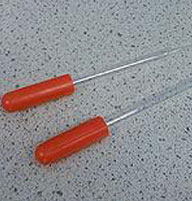Pipetas de Pasteur, también llamadas tuberías PAP, tubos de fluido, que normalmente se hacen de polímero polietileno (PE), etc. están divididos por dos pajitas de PAP en esterilización de rayos gamma y desinfección. Tienen volumen y longitud diferentes, se caracterizan por tener una cápsula hueca en el cuerpo del tubo, puede facilitar la mezcla de reactivos disolventes y el cuerpo de la célula, etc. Cuerpo de tubo traslúcido, de color blanco brillante, paredes movidos, fáciles de controlar. Pueden ser utilizadas para el ambiente de nitrógeno líquido; suave mientras el manejo, flexible, acceso conveniente al seguimiento y al recipiente especial; pequeña succión garantiza la repetibilidad del volumen de las gotas; Tubo de fluido puede ser termosoldado, conveniente de llevar. Experimento de aplicación de células principal, ensayos clínicos, clonación, etc. Admisión de una cantidad pequeña de líquido, transferencia o transportación, etc. Pipetas están ampliamente utilizadas en la genética, la medicina, la prevención de las epidemias, en campos clínicos, genéticos, bioquímicos, petroquímicas, militares y otros campos, pertenecen a los productos de laboratorio consumibles desechables.
Pipetas de Pasteur, también conocidas como goteros o cuentagotas, se utilizan para transferir pequeñas cantidades de líquidos. [1] son por lo general tubos de vidrio cónicos a un punto estrecho, y equipados con una bombilla de goma en la parte superior. La combinación de la pipeta de Pasteur y la bombilla de goma también se ha denominado pipeta con tetina. Las pipetas de Pasteur pueden ser de longitud diferente y se venden en cajas de cientos. [cita es necesaria] Pipetas llevan el nombre del científico francés Louis Pasteur, quien era conocido por haber usado una variante de pipetas extensivamente durante su investigación. Generalmente, se consideran suficientemente baratas para ser desechables, sin embargo, mientras el punto de vidrio no esté astillado, la pipeta de Pasteur puede lavarse y reutilizarse indefinidamente.
El nombre cuentagotas también puede referirse a los primeros modelos de plumas estilográficas, que se rellenan como algunos tipos de pipeta de Pasteur.
Características del producto+
|
Products information |
|||
|
Part No |
Volume(ml) |
Length |
Material |
|
PP01145 |
3 |
145 |
LDPE |
|
PP02150 |
2 |
150 |
LDPE |
|
PP03160 |
1 |
160 |
LDPE |
|
PP2100 |
0.2 |
100 |
LDPE |
|
PP5120 |
0.5 |
120 |
LDPE |


Technical Information+
Process Flow Diagram+
FAQ+
Inquiry
If you have any question or comment, please contact us without hesitation. We will reply you as soon as possible. ( * is required information)
¿TIENE ALGUNA PREGUNTA SOBRE NUESTROS PRODUCTOS?
CONTACTO